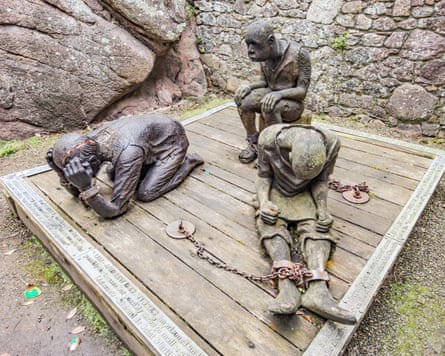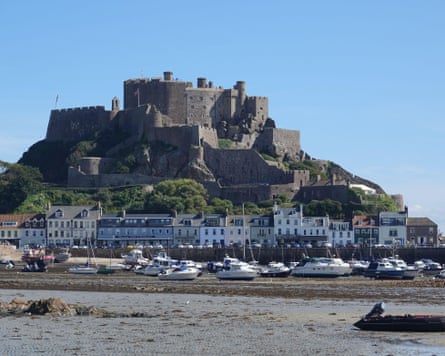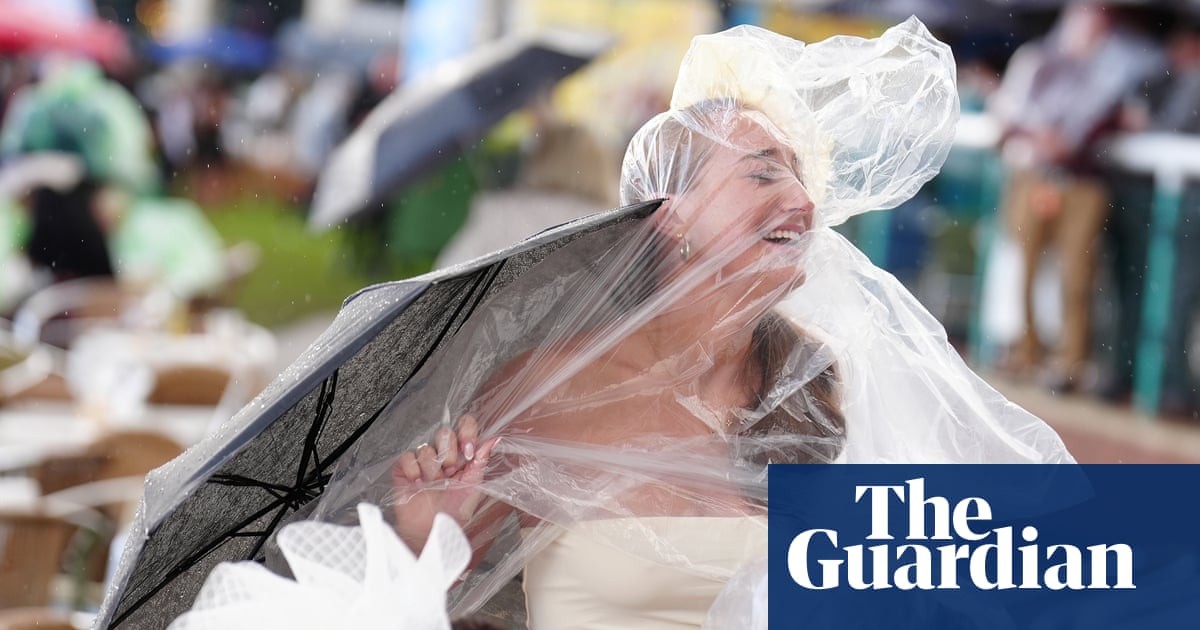Mont Orgueil is a medieval castle perched on the eastern coast of Jersey with beautiful views out over the shimmering sea. On a good day, you might even catch a glimpse of France. But the view won’t have been much consolation to those who were imprisoned here – locked up for a year and a day back in the 16th and 17th centuries – because they were accused of witchcraft. Such was the hunger for trying witches here that historian William Monter has called the Channel Islands “the witch-hunting capital of Atlantic Europe”.
Jersey’s witchy history first caught the imagination of Carolyn Rose Ramsay when she worked as a tour guide on the island. A Canadian native and former dancer for major ballet companies in Europe and the Americas, Ramsay soaked up local myths such as the “witch ledge”, built on the side of chimneys so that anyone on a passing broomstick would rest there rather than come down your chimney. She visited Rocqueberg Point, known as Witches’ Rock, where you can supposedly see the footprints of dancing sorceresses. But then she came across the grimmer real-life history of the trials.

In 2022, she set up Ballet d’Jèrri, Jersey’s own contemporary ballet company, and the stories of witches real and imagined, celebrated and persecuted, have inspired its new triple bill, with premieres from three female choreographers: Vidya Patel, Katya Bourvis and Cecilia Lisa Eliceche. It will be performed outdoors, against the atmospheric backdrop of La Hougue Bie, a neolithic burial site, or “passage tomb”, which is one of the oldest buildings in the world.
When I arrive at the company’s studio at the Jersey Opera House in St Helier, the dancers are rehearsing with choreographer Eliceche, who is clearly enjoying herself. “Yes! I love that,” she calls out, beaming, as the dancers pull off a tricky warp and weft sequence. She shows me some of the props they’ve been using. “We have a witch’s hat!” she exclaims, holding out a beautiful straw creation with a long, pointed crown which she brought from her home in Salvador, Brazil.
Eliceche has always loved tales of witches. Her mother’s family come from Zugarramurdi in Spain’s Basque Country, a supposed hotbed of witchcraft in the early 1600s, and she would visit the witches’ caves there. A self-described “experimental” choreographer, Eliceche has drawn on those memories to make her piece, alongside her own spiritual practice of Haitian vodou, tying in stories of present-day persecution, especially of the Mapuche women on the border of Chile and Argentina near where she was born, who have been put on trial for defending Indigenous land rights. Eliceche is having their names embroidered on to the dancers’ costumes.
She feels this project was made for her, which is funny because that’s exactly what Bourvis says when we speak: “I feel like all the work I’ve been doing was preparation for this!” Many women today are enticed by the sense of magic, ritual, feminine power and connection to the natural world that witchcraft in its various forms offers. Inevitably, the truth of Jersey’s witch trials is more grisly. In parallel with what was happening across Europe in a period of of religious fervour, women were accused, tried, tortured and murdered for supposed transgressions.

At the Jersey Archive, collections director Linda Romeril carefully places a bound volume of 16th-century court records on a pillow in front of us, all delicate pages and spidery calligraphy. She translates from the French the case of Symon Vauldin, accused in 1591 of having discourse with the devil in the form of a crow and a cat. “It says he’s confessed to the crime of witchcraft and he will be hanged and his body burned and reduced to cinders,” says Romeril. This is the first surprise to me. Not all the accused were women – about 20% were men like Vauldin, who was married with four children.
Many women were accused of diabolical acts, from casting evil spells to causing the deaths of humans and animals. From the scant surviving information, Romeril tries to put together a picture of who these women were. Some were from respectable families, with husbands and children. One, Andree Tourgis, was accused of killing her daughter’s illegitimate child and sentenced to death in 1608. Romeril wonders what the real story was: she may have been some sort of midwife – so was this a stillbirth or cot death, or even an illegal abortion?
In a small island community, there was also the possibility of family feuds, local disputes and jealousies being involved. And trials often coincided with periods of turmoil, such as the spread of plague in the late 1500s. Those accused of witchcraft may have practised some kind of alternative medicine, such as Jeanne Le Vesconte, who was accused of “infecting some and curing others”. They executed her nonetheless. Public hangings took place in what is now the Royal Square. “Hanged and strangled,” say some of the records.
By the mid-1600s, the charges were more predictable. Elizabeth Grandin was accused of leading a life that was “lustful, wicked and scandalous” and of having an illegitimate daughter to boot, while Guillemette du Vaistain had an affair with her brother-in-law. These women could have been tried for a moral crime in an ecclesiastical court, but adding witchcraft meant a potentially harsher sentence. What Bourvis wanted to explore in her piece, Flux, was the archetype of the witch as a symbol of “everything that’s not allowed. She represents messiness and sexuality and desire, but also intuition and wisdom and sisterhood”.

Flux is about womanhood and femininity, but also societal systems, “history continuing to repeat itself – and the way we are conditioned to behave because that’s the only way to survive”. Bourvis could be talking about any number of current social or geopolitical situations when she says: “The duality of ‘good’ or ‘bad’ creates this mass hysteria and insecurity, causing us to behave in the most harmful and heartless ways.”
Dr Adam Perchard, dramaturg on Ballet d’Jèrri’s production, also points to the pertinence of the theme: “Fear and suspicion of the other, the patriarchy trying to control the masses – is that the 16th century or is it the present day?” Meanwhile, Ramsay talks about today’s social media witch-hunts and how little it takes for people to pile on, “to join in with their pitchforks”.
Perchard is a writer-performer-cabaret artist and Jersey native who got hooked on the island’s witch trial history after hearing stories of resistance: of women who found loopholes in the law; refused to submit to the jury of 24 landowning men who would judge them; or endured their stay in Mont Orgueil without confessing, despite probably being tortured. (While Jersey has no evidence of the torture, in neighbouring Guernsey it is written into the court records: “Confessed under torture.”) Perchard cites the example of Du Vaistain, who did have her punishment downgraded. “But it wasn’t such a happy ending,” he says, “since she was sentenced ‘to be whipped all the way from the courthouse to the shore till the blood comes’. Then she’s banished for ever. But at least she had her life.”

From the 1560s to the 1660s, there were 65 trials, with 33 leading to execution. Others of the accused were banished, some died before trial, a handful were acquitted, and the fates of a few are unknown. It’s not a huge number across a century, but significant for a population of only 10,000. There are a lot of gaps in the records, which is partly why it’s such a fruitful topic for art: there is room for interpretation. We can’t assume that everyone was entirely innocent, says Romeril. “They’re all innocent of witchcraft, but they might not be innocent of other crimes. It’s just not black and white.”
After the 1660s, with the rise of the Enlightenment in Europe, the witch trials came to an end in Jersey, although by then the idea had taken hold in America. The Salem witch trials were in 1692 and 1693. These days witchcraft has a more benign reputation. Patel found herself drawn to the witch’s connection to earth, nature and the seasons – themes she often uses in her own choreography, which is based in the Indian classical form kathak. She describes the piece she has made for Ballet d’Jèrri, Mark Our Ashes, as “a reimagined ritual” honouring the people who lost their lives. Perchard introduced Patel to some of Jersey’s flourishing community of modern-day witches, with whom they’ve been hanging out. “I’ve been getting my witch on!” says Perchard, who goes on to recount a “divination through cocktails” meeting. “Everybody was getting out their rose flowers preserved in vodka under an Aquarius moon. And by the time we tried them all, we never got round to any divination.”
The sheer enthusiasm for the subject from the three choreographers proves that the figure of the witch captures imaginations still. Back at Mont Orgueil Castle, there is a decorative metal screen that pays tribute to the victims of the trials. You turn a handle and its mechanical parts creak into life. A small model of a witch on a broomstick twirls in jerky circles. The shrieking of the metal sounds just like a gleeful cackle.

 3 months ago
55
3 months ago
55

















































